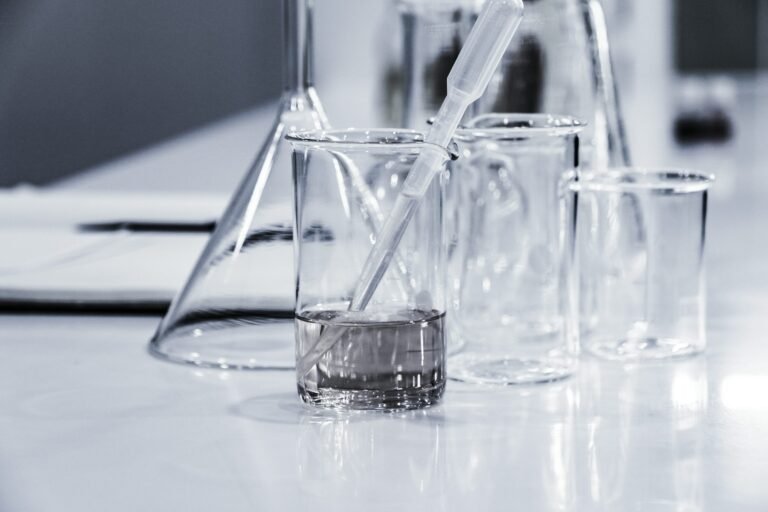Welcome to Bluewell’s comprehensive guide to peptide science terminology
This glossary serves as your essential reference for understanding the fascinating world of peptides — from fundamental amino acid concepts to advanced cellular biology mechanisms. Whether you’re beginning your peptide research journey or seeking to deepen your existing knowledge, this guide will help you navigate the scientific landscape with confidence.
Introduction to Peptide Science: Foundations and Frontiers
Peptides represent one of the most exciting frontiers in modern wellness and therapeutic research. These remarkable short chains of amino acids, linked by peptide bonds, orchestrate countless vital biological processes throughout the human body — from cellular signaling and hormone regulation to immune system modulation and tissue repair.
The power of peptides lies in their precision. By understanding key concepts like agonists (molecules that activate biological responses) and antagonists (molecules that block or reduce responses), along with how peptides interact with specific cellular receptors, you gain insight into how these sophisticated molecules can influence health, performance, and longevity outcomes.
This comprehensive glossary empowers you to speak the language of peptide science fluently, enabling more informed decisions about your research and wellness journey.
A-Z Peptide Science Terminology
A
Absorption
The process by which peptides enter the bloodstream through various administration routes, including subcutaneous injection, oral delivery, or nasal administration.
Acetylation
A chemical modification that can enhance peptide stability and bioavailability by adding acetyl groups to specific amino acids.
Active Site
The specific region on a receptor or enzyme where peptides bind to trigger their biological effects.
Agonist
A peptide or molecule that binds to and activates receptors, triggering the desired biological response. Many therapeutic peptides function as agonists.
Amino Acids
The fundamental building blocks of proteins and peptides. Each contains a central carbon atom, an amino group, a carboxyl group, and a unique side chain that determines its properties and function.
Anabolic
Referring to metabolic processes that build up tissues and molecules. Many peptides support anabolic processes for muscle growth and tissue repair.
Antagonist
A molecule that binds to receptors but blocks or reduces their activity, often used therapeutically to modulate excessive biological responses.
B
Bioactive Peptides
Peptides that exert beneficial biological effects on the body, including antimicrobial, antioxidant, immune-modulating, or tissue-regenerating properties.
Bioavailability
The degree to which peptides can be absorbed and utilized by the body, varying significantly based on administration method and molecular structure.
Biosynthesis
The natural cellular process of creating peptides and proteins from amino acid precursors.
BPC-157
A synthetic peptide derived from body protection compound, extensively researched for its remarkable healing and regenerative properties across multiple tissue types.
C
Catabolism
The breakdown of complex molecules into simpler ones. Some peptides help regulate catabolic processes to optimize recovery and tissue maintenance.
Cell Membrane
The protective lipid barrier surrounding cells that controls molecular entry and exit. Peptides interact with membrane receptors to influence cellular function.
Cell Signaling
The complex communication system cells use to coordinate responses. Peptides serve as crucial signaling molecules in this network.
CJC-1295
A synthetic growth hormone-releasing hormone analog known for its extended half-life and potential to stimulate natural growth hormone production.
Cleavage
The process of breaking peptide bonds, either naturally through enzymatic action or intentionally during peptide synthesis.
Collagen Peptides
Bioactive peptides derived from collagen that support skin health, joint function, and connective tissue integrity.
Cytokines
Small signaling proteins that facilitate cellular communication, particularly in immune responses. Many peptides influence cytokine production.
D
Degradation
The natural breakdown of peptides in the body. Understanding degradation patterns helps optimize dosing and timing protocols.
Dimerization
The process where two peptide molecules join together, sometimes enhancing their biological activity or stability.
Dosing Protocol
The systematic approach to peptide administration, including timing, frequency, and dosage amounts for optimal results.
E
Endogenous
Naturally produced within the body. Many therapeutic peptides are synthetic versions of endogenous compounds.
Endoplasmic Reticulum (ER)
The cellular organelle responsible for protein and peptide synthesis, modification, and quality control.
Enzyme
Specialized proteins that catalyze biochemical reactions. Peptides often influence enzyme activity to achieve therapeutic effects.
Epitalon
A synthetic tetrapeptide researched for its potential anti-aging properties and effects on circadian rhythm regulation.
Exogenous
Originating from outside the body, such as synthetic peptides administered for research or therapeutic purposes.
F
Folding
The process by which peptide chains assume their functional three-dimensional structure, critical for biological activity.
Fragment
A portion of a larger peptide or protein that retains specific biological activities.
G
GHK-Cu
A copper-peptide complex renowned for its skin rejuvenation and wound healing properties, supporting collagen synthesis and tissue repair.
GHRH (Growth Hormone-Releasing Hormone)
A natural peptide hormone that stimulates growth hormone release from the pituitary gland.
GHRP (Growth Hormone-Releasing Peptides)
A class of synthetic peptides designed to stimulate natural growth hormone secretion, including GHRP-6, GHRP-2, and Ipamorelin.
Glucagon
A peptide hormone that regulates blood glucose levels by promoting glucose release from the liver.
Glycosylation
The addition of carbohydrate groups to peptides, which can enhance stability and modify biological activity.
Golgi Apparatus
The cellular “packaging center” that modifies and processes peptides before they reach their final destinations.
H
Half-Life
The time required for half of an administered peptide to be eliminated from the body, important for determining dosing frequency.
Hexarelin
A synthetic growth hormone-releasing peptide known for its potent GH-stimulating properties.
Homeostasis
The body’s natural balance. Many peptides help maintain or restore homeostatic equilibrium.
Hydrolysis
The breakdown of peptide bonds through reaction with water, often mediated by specific enzymes.
I
IGF-1 (Insulin-like Growth Factor-1)
A peptide hormone that mediates many of growth hormone’s anabolic effects on tissues.
IGF-1 LR3
A modified version of IGF-1 with enhanced stability and longer half-life, researched for its potential muscle-building and recovery benefits.
Immunomodulation
The modification of immune system activity. Several peptides possess immunomodulatory properties.
In Vitro
Research conducted in laboratory conditions outside living organisms, often the first step in peptide research.
In Vivo
Research conducted within living organisms, providing more comprehensive data on peptide effects.
Ipamorelin
A selective growth hormone secretagogue known for its clean growth hormone release profile with minimal side effects.
L
Ligand
Any molecule that binds to a specific protein receptor. Peptides often function as natural or synthetic ligands.
Lipopeptides
Peptides conjugated with lipid groups to enhance membrane penetration and bioavailability.
Lyophilization
The freeze-drying process used to preserve peptides in stable, powdered form for long-term storage.
M
Melanotan II
A synthetic analog of melanocyte-stimulating hormone researched for its effects on pigmentation and other physiological responses.
Metabolism
The chemical processes that maintain life. Many peptides influence metabolic pathways to optimize energy production and utilization.
Mitochondrial Peptides
Peptides that originate from mitochondrial DNA or regulate mitochondrial function, impacting cellular energy production.
Modification
Chemical changes made to peptides to enhance their stability, potency, or bioavailability.
MOD GRF 1-29
A modified form of growth hormone-releasing factor with enhanced stability and biological activity.
N
Neuropeptides
Peptides that function as neurotransmitters or neuromodulators in the nervous system, influencing mood, cognition, and behavior.
Nucleus
The cellular control center containing DNA. Peptide signaling often influences nuclear processes like gene expression.
O
Oligopeptide
Short peptides containing 2-20 amino acids, often highly bioactive despite their small size.
Oxidation
A chemical process that can degrade peptides. Proper storage and handling minimize oxidative damage.
P
Peptide Bond
The chemical linkage between amino acids formed when one amino acid’s carboxyl group joins another’s amino group.
Peptide Hormones
Naturally occurring peptides that function as hormones, regulating essential physiological processes.
Peptidomimetics
Synthetic molecules designed to mimic natural peptides while offering improved pharmaceutical properties.
Pharmacokinetics
The study of how peptides are absorbed, distributed, metabolized, and eliminated by the body.
Pituitary Gland
The master endocrine gland that releases many important peptide hormones, often targeted by therapeutic peptides.
Polypeptide
Longer chains of amino acids; those with more than 50 amino acids are typically classified as proteins.
Post-translational Modification
Changes made to peptides after synthesis that can alter their function, stability, or localization.
Potency
The strength or effectiveness of a peptide at producing its desired biological effect.
Purity
The percentage of the desired peptide in a sample, with higher purity (95%+) generally indicating better quality and consistency.
R
Receptor
Specialized protein structures that bind specific peptides and trigger cellular responses.
Reconstitution
The process of dissolving lyophilized peptides in appropriate solvents for administration.
Regeneration
The renewal or restoration of tissues. Many peptides support regenerative processes throughout the body.
Retatrutide
A novel triple receptor agonist peptide being researched for its potential metabolic benefits and weight management properties.
Ribosome
Cellular structures that synthesize peptides and proteins according to genetic instructions.
S
Secretagogue
A substance that stimulates secretion of hormones or other compounds. Many peptides function as secretagogues.
Selank
A synthetic peptide derived from tuftsin, researched for its potential nootropic and anxiolytic properties.
Selectivity
The ability of peptides to target specific receptors or pathways while minimizing off-target effects.
SEMAX
A synthetic peptide based on ACTH, studied for its potential cognitive-enhancing and neuroprotective effects.
Sermorelin
A synthetic peptide that stimulates natural growth hormone release, often used in anti-aging research.
Signal Peptide
A short amino acid sequence that directs newly synthesized peptides to specific cellular locations.
Somatostatin
A peptide hormone that inhibits the release of several other hormones, providing regulatory balance.
Stability
The ability of peptides to maintain their structure and activity over time and under various conditions.
Stacking
The practice of combining multiple peptides to achieve synergistic effects and enhanced results.
Synthesis
The artificial production of peptides using chemical or biological methods.
T
TB-500
A synthetic peptide based on Thymosin Beta-4, researched for its potential in tissue repair and regeneration.
Tesamorelin
A synthetic growth hormone-releasing hormone analog used in research for its metabolic effects.
Thymosin Alpha-1
An immune-modulating peptide researched for its potential to enhance immune system function.
Titration
The process of gradually adjusting peptide dosages to find the optimal amount for individual responses.
Transdermal
Administration through the skin, an alternative delivery method for certain peptides.
U
Upstream
Referring to processes that occur earlier in a biological pathway. Peptides often work upstream to influence multiple downstream effects.
V
Vascularity
The development of blood vessels. Some peptides support vascular health and development.
Viscosity
The thickness of reconstituted peptide solutions, which can affect ease of administration.
W
Water for Injection (WFI)
Sterile water specifically prepared for reconstituting peptides and other injectable substances.
Why Understanding These Terms Matters
Mastering peptide terminology empowers you to:
- Make Informed Decisions: Understanding the science behind peptides helps you choose the most appropriate compounds for your research goals
- Optimize Results: Knowledge of concepts like bioavailability, half-life, and receptor selectivity enables better protocol development
- Communicate Effectively: Speaking the language of peptide science facilitates meaningful discussions with healthcare providers and researchers
- Stay Current: As peptide research evolves rapidly, foundational knowledge helps you understand new developments and applications
Conclusion: Your Gateway to Peptide Mastery
This comprehensive glossary serves as your foundation for exploring the exciting world of peptide science. From basic amino acid concepts to advanced cellular mechanisms, these terms provide the vocabulary needed to navigate peptide research with confidence and precision.
As you continue your journey into peptide science, refer back to this glossary whenever you encounter unfamiliar terminology. The field continues to evolve, bringing new discoveries and applications that build upon these fundamental concepts.
Ready to put this knowledge into practice? Explore Bluewell’s premium peptide selection, where cutting-edge science meets exceptional quality to support your research and wellness goals.
This glossary provides educational information for research purposes. Terms and concepts are presented to enhance understanding of peptide science and should not be considered medical advice.





Hi, this is a comment.
To get started with moderating, editing, and deleting comments, please visit the Comments screen in the dashboard.
Commenter avatars come from Gravatar.